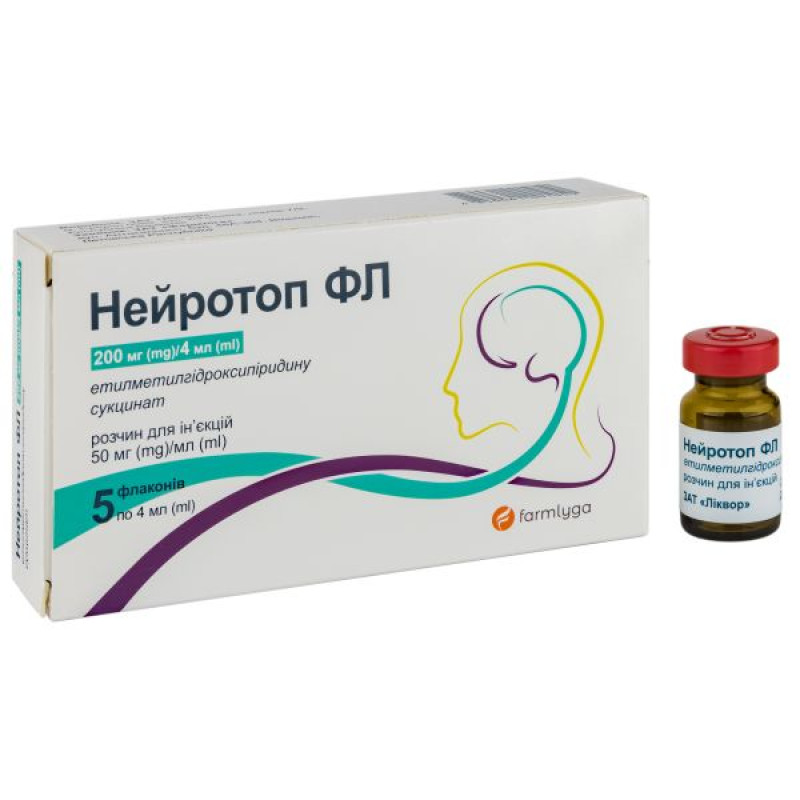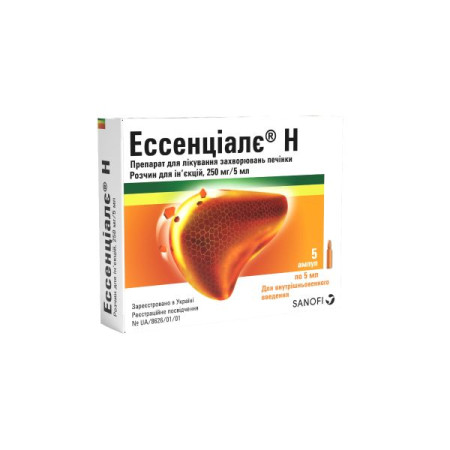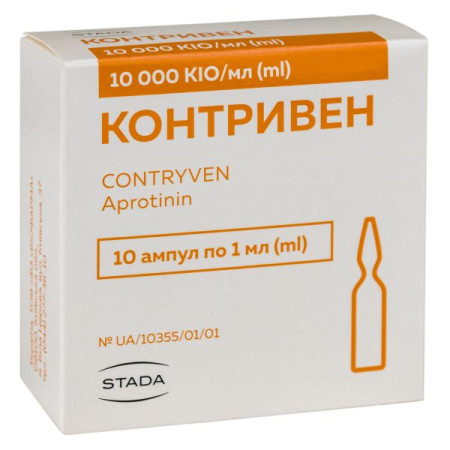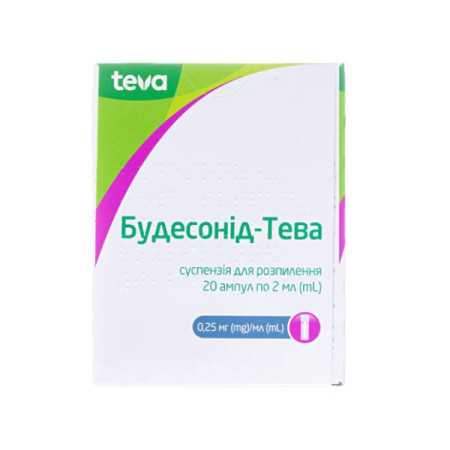Neurotop FL solution for injection 200 mg/4 ml bottle 4 ml No. 5
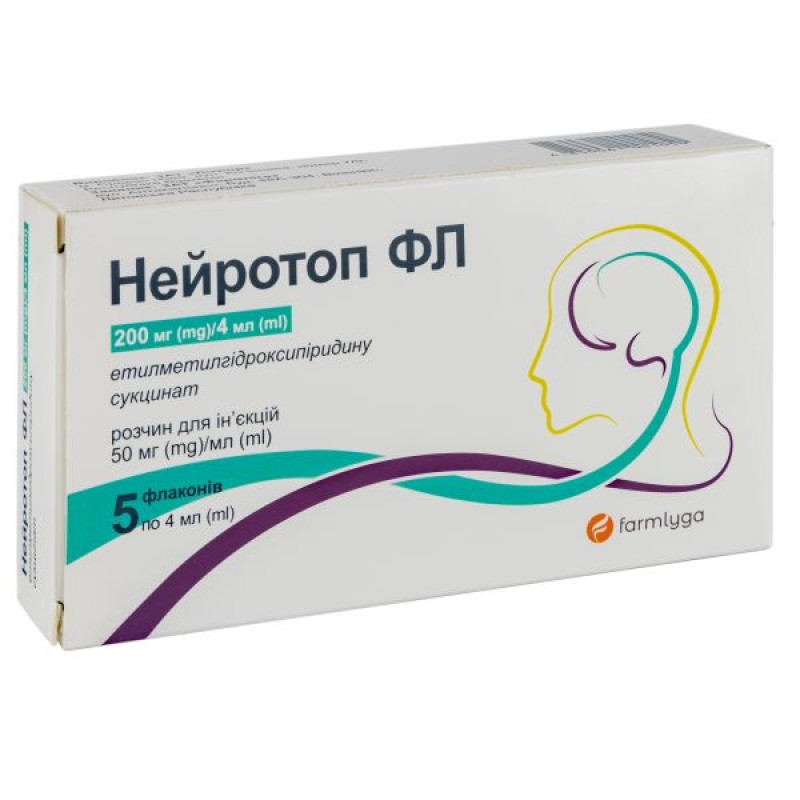
Instructions Neurotop FL solution for injection 200 mg/4 ml bottle 4 ml No. 5
Composition
active ingredient: ethylmethylhydroxypyridine succinate;
1 ml of solution contains ethylmethylhydroxypyridine succinate 50 mg;
Excipients: sodium metabisulfite, water for injections.
Dosage form
Solution for injection.
Main physicochemical properties: colorless or slightly yellowish transparent liquid.
Pharmacotherapeutic group
Agents acting on the nervous system. Other agents acting on the nervous system. ATX code N07X X.
Pharmacological properties
Pharmacodynamics
The drug has antihypoxic, antioxidant, membrane-protective, nootropic, anxiolytic, stress-protective, and anticonvulsant effects.
It is an inhibitor of free radical processes, inhibits lipid peroxidation processes, increases the activity of superoxide oxidase, increases the lipid-protein ratio, reduces membrane viscosity, increases its fluidity. Modulating the activity of membrane-bound enzymes (calcium-independent phosphodiesterase, adenylate cyclase, acetylcholinesterase), receptor complexes (benzodiazepine, gamma-aminobutyric acid (GABA), acetylcholine), enhancing their ability to bind to ligands, it contributes to the preservation of the structural and functional organization of biomembranes, improves the transport of neurotransmitters and synaptic transmission. Increases the content of dopamine in the brain. The drug Neurotop FL enhances the compensatory activity of aerobic glycolysis, reduces the degree of inhibition of oxidative processes in the Krebs cycle under conditions of hypoxia, increases the content of adenosine triphosphoric acid (ATP) and creatine phosphate, and activates the energy-synthesizing function of mitochondria.
The drug increases the body's resistance to the action of various factors in pathological conditions (shock, hypoxia and ischemia, impaired cerebral circulation, intoxication with alcohol and antipsychotic drugs - neuroleptics). The drug Neurotop FL improves metabolism and blood supply to the brain, microcirculation and rheological properties of blood, reduces platelet aggregation. Stabilizes blood cell membranes (erythrocytes and platelets), preventing hemolysis. The drug has a hypolipidemic effect, reduces the level of total cholesterol and low-density lipoproteins (LDL). It reduces enzymatic toxemia and endogenous intoxication in acute pancreatitis. The drug normalizes metabolic processes in ischemic myocardium, reduces the area of necrosis, restores and improves electrical activity and myocardial contractility, and also increases coronary blood flow in the area of ischemia, reduces the effects of reperfusion syndrome in acute coronary insufficiency. Increases the antianginal activity of nitro drugs.
The drug Neurotop FL helps preserve retinal ganglion cells and optic nerve fibers in progressive neuropathy caused by chronic ischemia and hypoxia; improves the functional activity of the retina and optic nerve, increasing visual acuity.
Pharmacokinetics
Absorption. When administering Neurotop FL in doses of 400–500 mg, the maximum concentration (Cmax) in blood plasma is 3.5–4.0 μg/ml and is achieved within 0.45–0.5 hours.
Distribution. Rapidly passes from the bloodstream into organs and tissues. After intramuscular administration, the drug is detected in blood plasma within 4 hours. The average retention period of the drug in the body is 0.7–1.3 hours.
Metabolism: Metabolized in the body by intensive conjugation with glucuronic acid.
Excretion: Rapidly excreted from the body in urine: mainly in glucuronide conjugated form, in small amounts - in unchanged form.
Indication
Acute cerebrovascular disorders;
dyscirculatory encephalopathy;
neurocirculatory dystonia;
traumatic brain injury, consequences of traumatic brain injuries;
mild cognitive disorders of atherosclerotic origin;
acute myocardial infarction (from the first day) – as part of complex therapy;
anxiety disorders in neurotic and neurosis-like conditions;
alcohol withdrawal syndrome with a predominance of neurosis-like and vegetative-vascular disorders;
acute intoxication with antipsychotic drugs;
acute purulent-inflammatory processes of the abdominal cavity (acute necrolytic pancreatitis, peritonitis) - as part of complex therapy;
primary open-angle glaucoma (at all stages) – as part of complex therapy.
Contraindication
Increased individual sensitivity to the drug;
acute liver and kidney dysfunction;
childhood;
pregnancy;
breastfeeding period.
Interaction with other medicinal products and other types of interactions
The drug Neurotop FL enhances the effect of benzodiazepine anxiolytics, anticonvulsants (carbamazepine), antiparkinsonian drugs (levodopa). Potentiates the effect of nitro-containing drugs, hypotensive drugs. Reduces the toxic effect of ethyl alcohol. Increases the antianginal activity of nitro drugs and the antihypertensive activity of ACE and β-blockers. Concomitant use with nibentan, propranolol and verapamil reduces the risk of developing the arrhythmogenic effects of the latter, concomitant use with neuroleptics reduces the risk of developing and severity of adverse reactions of the latter.
Application features
In some cases, especially in patients with a limited allergic history, in patients with bronchial asthma, with increased sensitivity to sulfites, the development of severe hypersensitivity reactions is possible.
The medicine contains sodium metabisulfite, which may cause hypersensitivity reactions and bronchospasm.
The drug should be used with caution in patients with diabetic retinopathy (the course should not exceed 7-10 days) due to the property of potentiating proliferative processes. After completion of parenteral administration, it is recommended to continue using the drug orally in the form of tablets to maintain the achieved effect.
Use during pregnancy or breastfeeding
Controlled clinical studies on the safety of the drug during pregnancy and breastfeeding have not been conducted. The drug is contraindicated during pregnancy and breastfeeding.
Ability to influence reaction speed when driving vehicles or other mechanisms
During treatment with the drug, it is not recommended to drive vehicles or work with complex machinery, machines, or any complex equipment that requires increased concentration and quick reaction.
Method of administration and doses
Intramuscularly or intravenously (jet or drip). Doses are selected individually. With the infusion method of administration, the drug is diluted in physiological sodium chloride solution.
The drug is administered slowly by jet injection over 5–7 minutes, and drip injection at a rate of 40–60 drops per minute.
Adults begin treatment with a dose of 50–100 mg 1–3 times a day, gradually increasing the dose until a therapeutic effect is obtained. The maximum daily dose should not exceed 800 mg.
In acute cerebrovascular accidents: prescribed as part of complex therapy in the first 2–4 days intravenously or drip to adults 200–300 mg once a day, then intramuscularly 100 mg 3 times a day. The duration of treatment is 10–14 days.
For traumatic brain injury and consequences of traumatic brain injury: used for 10–15 days by intravenous drip injection of 200–500 mg 2–4 times a day.
In case of dyscirculatory encephalopathy (decompensation phase): intravenously by jet or drip at a dose of 100 mg 2–3 times a day for 14 days. Then the drug is administered intramuscularly at 100 mg per day for the next 2 weeks.
For course prevention of dyscirculatory encephalopathy: the drug is administered intramuscularly to adults at a dose of 100 mg 2 times a day for 10–14 days.
For mild cognitive impairment in elderly patients and anxiety states: the drug is administered intramuscularly at a dose of 100–300 mg per day for 14–30 days.
In acute myocardial infarction as part of complex therapy: administered intravenously or intramuscularly for 14 days, against the background of traditional myocardial infarction therapy, which includes nitrates, beta-blockers, angiotensin-converting enzyme (ACE) inhibitors, thrombolytics, anticoagulants and antiplatelet agents, as well as symptomatic agents according to indications. In the first 5 days, to achieve maximum effect, intravenous administration is desirable. In the next 9 days, a transition to intramuscular administration is possible. Intravenous administration is carried out by drip infusion, slowly (to avoid side effects), in 0.9% sodium chloride solution or 5% dextrose (glucose) solution in a volume of 100–150 ml for 30–90 minutes. If necessary, a slow jet injection of the drug lasting at least 5 minutes is possible.
The drug is administered (intravenously or intramuscularly) 3 times a day every 8 hours. The daily therapeutic dose is 6–9 mg/kg of body weight per day, a single dose is 2–3 mg/kg of body weight. The maximum daily dose should not exceed 800 mg, a single dose is 250 mg.
For neurocirculatory dystonia: intramuscularly 100–200 mg 1–2 times a day for 10–15 days.
For open-angle glaucoma of various stages as part of complex therapy: administered intramuscularly at 100–300 mg per day, 1–3 times a day, for 14 days.
For alcohol withdrawal syndrome: administered at a dose of 100–200 mg intramuscularly 2–3 times a day or intravenously drip 1–2 times a day for 5–7 days.
In acute purulent-inflammatory processes of the abdominal cavity (acute necrotic pancreatitis, peritonitis): the drug is prescribed on the first day of both the preoperative and postoperative periods. The doses depend on the form and severity of the disease, the prevalence of the process, and the clinical course. The drug should be discontinued gradually, only after a stable positive clinical and laboratory effect.
In acute edematous (interstitial) pancreatitis: adults are prescribed 100 mg 3 times a day intravenously drip (in isotonic sodium chloride solution) and intramuscularly.
For mild necrotizing pancreatitis: 100–200 mg 3 times a day administered intravenously drip (in isotonic sodium chloride solution) and intramuscularly.
For moderate necrotizing pancreatitis: adults are administered 200 mg 3 times a day intravenously drip (in isotonic sodium chloride solution).
In severe necrotizing pancreatitis: dose of 800 mg on the first day in two doses, then 300 mg 2 times a day with a gradual decrease in the daily dose.
Very severe course: the initial dose is 800 mg per day until stable relief of pancreatogenic shock, after stabilization of the condition - 300–400 mg 2 times a day intravenously drip (in isotonic sodium chloride solution) with a gradual decrease in the daily dose.
Children
Strictly controlled clinical studies of the safety of the drug in children have not been conducted, therefore the drug Neurotop FL is contraindicated for use in this category of patients.
Overdose
In case of overdose, drowsiness or insomnia is possible, with intravenous administration in some cases a short-term and slight increase in blood pressure is possible. Treatment - detoxification therapy. The development of symptoms of overdose usually does not require the use of antipyretics. These symptoms of sleep disorders disappear on their own within a day. In especially severe cases, the use of one of the tableted hypnotics and anxiolytics (nitrazepam 10 mg, oxazepam 10 mg or diazepam 5 mg) is recommended. In case of excessive increase in blood pressure, antihypertensive drugs should be used under blood pressure control and/or therapy should be supplemented with nitro-containing drugs.
Side effects
To avoid adverse reactions, it is recommended to adhere to the dosage regimen and rate of administration of the drug. The frequency of adverse reactions was determined according to the classification of the World Health Organization (WHO): very common (≥ 10%); common (≥ 1%, but ≤ 10%); uncommon (≥ 0.1%, but ≤ 1%); rare (≥ 0.01%, but ≤ 0.1%); very rare (≤ 0.01%); frequency unknown (frequency cannot be estimated from the available data).
On the part of the immune system: very rarely - anaphylactic shock, angioedema, urticaria; frequency unknown - allergic reactions, hyperemia, severe hypersensitivity reactions are possible.
Mental disorders: very rarely - drowsiness; frequency unknown - sleep disturbance, feeling of anxiety, emotional reactivity.
Cardiovascular system: frequency unknown - palpitations, tachycardia.
From the nervous system: very rarely - headache, dizziness (may be associated with an excessively high rate of administration and be short-term); frequency unknown - impaired coordination, tremor.
Vascular: very rarely - decreased blood pressure, increased blood pressure (may be associated with an excessively high rate of administration and be short-term).
On the part of the respiratory system, chest organs and mediastinum: very rarely - dry cough, sore throat, chest discomfort, difficulty breathing (may be associated with an excessively high rate of administration and be of a short-term nature); frequency unknown - bronchospasm.
On the part of the digestive system: very rarely - dry mouth, nausea, bad breath, metallic taste in the mouth; frequency unknown - dyspeptic disorders, diarrhea.
Skin and subcutaneous tissue disorders: very rarely - itching, rash, facial flushing; frequency unknown - distal hyperhidrosis.
General disorders and administration site conditions: very rare – feeling of warmth; frequency unknown – changes at the injection site.
Against the background of long-term administration of the drug, the following adverse reactions may occur: flatulence, weakness, peripheral edema.
Reporting of suspected adverse reactions
Reporting adverse reactions after the registration of a medicinal product is important. This allows monitoring of the benefit/risk ratio of the medicinal product. Medical and pharmaceutical professionals, as well as patients or their legal representatives, should report all cases of suspected adverse reactions and lack of efficacy of the medicinal product via the automated pharmacovigilance information system at the link: https://aisf.dec.gov.ua.
Expiration date
3 years.
Storage conditions
Store at a temperature not exceeding 25 °C in a place protected from light. Keep out of the reach of children.
Incompatibility
Cases of incompatibility with drugs of other pharmacological groups have not been described.
Packaging
2 ml in amber glass vials, sealed with rubber stoppers, crimped with aluminum caps with red flip-offs. 5 vials in a transparent contour blister pack. 1 contour blister pack in a cardboard pack.
4 ml in amber glass vials, sealed with rubber stoppers and crimped with red aluminum caps. 5 vials in a transparent blister pack. 1 blister pack in a cardboard box.
Vacation category
According to the recipe.
Producer
CJSC "Liquor".
Location of the manufacturer and address of its place of business.
Yerevan 0089, Kochinyan St., number 7/9, Republic of Armenia.
Applicant
CJSC "Farmlyga"/UAB "Farmlyga".
Location of the applicant. Antakalnio g. 48A-304, Vilnius, Republic of Lithuania.
There are no reviews for this product.
There are no reviews for this product, be the first to leave your review.
No questions about this product, be the first and ask your question.








